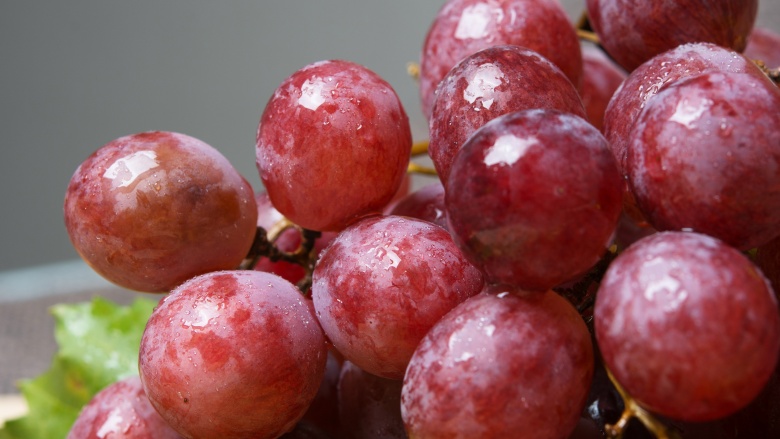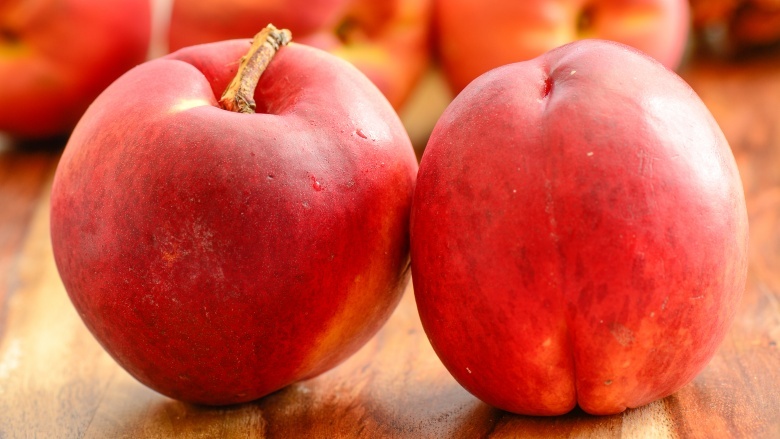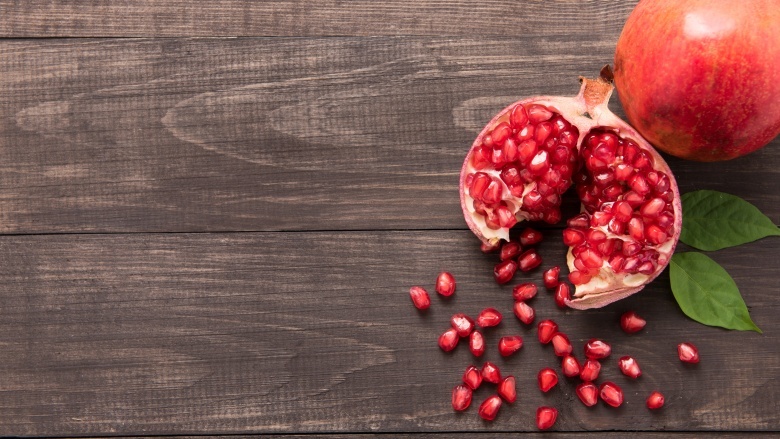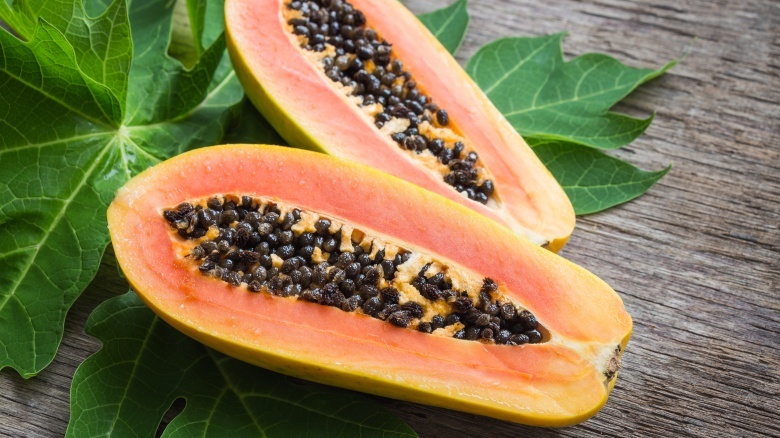11 Hacks For Peeling Fruit Quickly
Come on, do you really need separate appliances to peel oranges and mangoes? Forget the useless kitchen tools that cost a bundle—they most likely won't work and will just waste your time. But then how do you tackle that pile of pomegranates you bought on sale? Every fruit is different, and some are more difficult to break down than others. Most of us have experience in peeling common fruits like oranges, but there are even tricks to help you do this quickly. The next time someone sees you peeling fruit using these hacks, you'll look like an absolute genius.
Oranges
You may know how to peel an orange, but you probably look quite barbaric while doing it. Using your nails to rip off the peel and tearing at the segments inside is a sticky nightmare. Imagine all the time you'll save by using a knife instead of your hands. Grab a sharp knife and slice the top of the orange rind off. Do the same to the bottom, making sure you don't cut too deep. Cutting lengthwise and unrolling the orange will reveal all of the delicious orange segments. You can easily pluck these off the rind, and onlookers will think you're a borderline genius.
Apples
Apple peels are delicious and nutritious. But there are times when the peels just won't work in a recipe. Nimble-fingered folks can make pretty good time using a basic paring knife to trim away peels, and the rest of us will usually reach for a peeler. Both are fine if you just have a few apples. If the job is bigger, peeling can be pretty time-consuming. The solution to this problem lies in your tool box. Grab your power drill to shave away the peels in no time flat.
Fit the drill with a spade drill bit and use it to skewer an apple through its core. Then, while pressing the blade of a peeler against the apple skin, turn the drill on. The apple will spin and the skin will peel off. You'll probably want to use a y-shaped peeler with a good, sharp blade.
Mangoes
If you're not comfortable wielding a knife ... well, you probably shouldn't be in the kitchen. But if you find yourself in a scenario where you must peel a mango, there is a simple hack that will keep you away from the knives. Mangoes have a multicolored skin that is thick and also has quite a slippery inside. This makes them difficult to peel. But mangoes are a fantastic fruit, rich in B vitamins and absolutely delicious. This is the safest way to peel a mango.
Start by cutting the mango along the seed, located in the center. Take one of the mango slices and find the spot where the flesh meets the skin. Align this onto the edge of a drinking glass. Now push until the skin is separated from the rest of the fruit. You're left with a delicious slab of this fruit, minus the unpleasant seed and rough skin.
Mango hedgehog
If you need to dice a mango after cutting the two halves from the pit, it's best to leave the skin on and cut the mango hedgehog style. If you remove the skin first, dicing can be a slippery job. The skin keeps the flesh in place and lets you cut uniformly diced pieces. Next, press to invert the skin so that it goes from convex to concave and pops out the fruit to resemble a hedgehog. Slide your knife between the skin and the flesh to release the diced fruit or use a spoon to scoop out the diced pieces.
Grapes
Peeled grapes dredge up thoughts of the fussiest dishes like back-in-the-day chicken salad for ladies who lunch. Once in a while, however, the need to skin a few grapes does come along. Sometimes it's for a whimsical moment like spooky "eyeballs" for Halloween and other times it might be for a high-end garnish like smoked grapes. Whatever the need, peeling grapes is boring. The easiest way to peel grapes is to blanch them first. Dunk grapes into a pot of boiling water for a few seconds to loosen their skins, then follow up with a quick dip in ice water to prevent the grapes from actually cooking. Next, make a small cut in the skin and gently squeeze to pop the grape out.
Grapefruit
Peeling grapefruit and some oranges with your fingers can turn into a messy affair. Use this amazingly easy trick to cleanly peel grapefruit and other citrus fruits: score the grapefruit skin using a paring knife. Make four vertical cuts to divide the grapefruit into quarters, but only cut through the skin. Then use your fingers to pull off the peel. Remove any residual white pith (it can be bitter) and separate the grapefruit into sections. You can also do this without a knife by breaking the fruit apart into its natural wedges. It takes a little more finesse, but it's a great trick to use when you're on the go and don't have a knife handy.
Kiwi
Open up your silverware drawer and pull out an everyday teaspoon to remove the delicate brown skin from a kiwi in one fell swoop. The spoon method takes about 30 seconds to complete. Simply slice off both the top and bottom of the fruit. Slide the teaspoon between the skin (which is actually edible) and the green flesh. Keep as close to the skin as possible and push the spoon, using the contour of the fruit as your guide, to separate the skin from the flesh.
Pineapple
Getting a pineapple out of its shell without any of those little brown eyes left on the flesh isn't easy. Since the fruit is super juicy, the cutting board can get pretty slick and the job can become a little dangerous if you're using a knife. A pineapple corer makes it possible to remove the fruit quickly and safely. After trimming the leaves off the top to expose the flesh, let the pineapple corer take over. Place the corer on top of the exposed flesh and twist the handle to drill down and core the fruit. (You can slice the fruit too depending on the type of coring tool you use.) Pull up the handle and the pineapple meat comes up out of the shell, ready to eat.
Peaches
Peaches are a fruit that doesn't necessarily have to be peeled; they taste just as delicious with the skin on as they do off. But if you're cooking a recipe that requires peeled peaches, you're probably scratching your head trying to figure out how to prepare them. We don't blame you; the soft flesh of this fruit makes it a daunting job. But never fear! There is a way to easily remove the skin of this delectable fruit without damaging the precious interior.
Using a knife, score the bottom of the peach with an X. You've already started peeling, but don't get carried away. The X is just to make them easier to peel at the end of the process. Submerge the fruit in a pot of boiling water for no more than 30 seconds. Remove the peaches from the water and place them directly in an ice bath. Once the fruit is cool enough to handle, peel the softened skin from the peach by starting at that handy X you scored on the bottom. (This is a process called blanching, and it can be used to peel many vegetables and fruits or to preserve their bright colors.) That wasn't so hard, was it?
Pomegranate
Do not try to break down a pomegranate without being prepared! If you want to try your luck and peel one of these on your own, your dry cleaning bill will be quite expensive this month. The red juice from this fruit has a tendency to stain clothing. So unless you want to look like you've just spent the afternoon in a butcher shop, we suggest using this simple hack. Just by preparing pomegranates in a bowl of water, you can make the cleanup easier and soften the outside of the fruit.
The inside of a pomegranate doesn't actually have a soft interior that you want to eat. The desired part of the pomegranate is actually the seeds. To get to this precious treasure, first fill a large bowl with water. Then score the pomegranate before lowering it into the bowl. This makes it easier for you to separate the two halves with your hands. You'll see a gush of red juice leak into the water. While you still have the fruit underwater, use a spoon to scoop out the seeds.
Voila! Now you just need to get to those seeds. Instead of scooping them out of the water, strain the bowl of pomegranate pieces in a sieve.
Papaya
The first step in peeling anything is choosing ripe produce. If you start off with a piece of fruit that is underripe or too mushy, you're doomed before you begin. Look for a papaya that is turning from green to yellow in color—you want one that is mostly yellow. When you press into the fruit, you should be able to make an indent with your thumb, but make sure the flesh isn't too mushy. If the papaya is overripe, it will be incredibly difficult to separate the flesh from the skin. You'll be left with a gooey disaster.
Cut the papaya in half lengthwise. The center of the papaya is filled with black seeds. Papaya seeds are edible but taste peppery. Use a spoon to scoop them out, being careful not to scoop too deep and lose precious fruit. Now you can eat the fruit by scooping the papaya right out of the skin.





